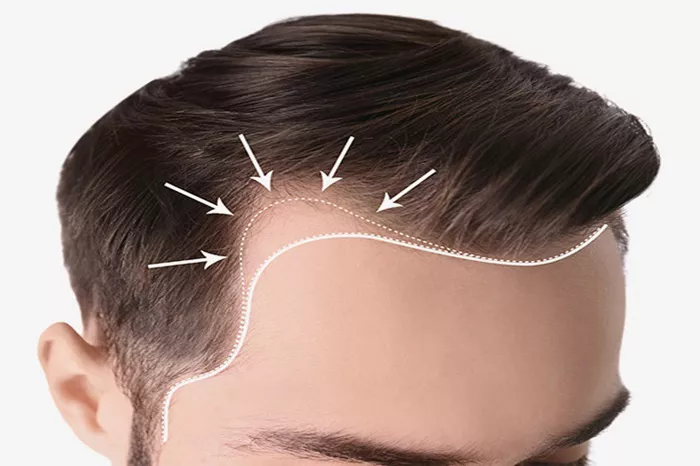Hair loss, particularly a receding hairline, is a common concern for many individuals, especially men. This condition can affect self-esteem and confidence. Hair transplant surgery has emerged as a popular solution. This article explores whether hair transplants work for a receding hairline.
Understanding Hair Transplants
Hair transplant surgery involves moving hair follicles from one part of the body (usually the back or sides of the head) to the balding or thinning areas. There are two main techniques:
Follicular Unit Transplantation (FUT): This method involves removing a strip of skin with hair follicles from the donor area. The strip is divided into small grafts and transplanted to the receding hairline.
Follicular Unit Extraction (FUE): In this technique, individual hair follicles are extracted from the donor area and transplanted to the receding hairline. FUE is less invasive and leaves minimal scarring.
Causes of Receding Hairline
A receding hairline can result from various factors, including:
Genetics: The most common cause is male pattern baldness, a hereditary condition.
Hormones: Androgens, particularly dihydrotestosterone (DHT), can shrink hair follicles, leading to hair loss.
Age: Hair naturally thins with age.
Stress: Physical and emotional stress can trigger hair loss.
Medical Conditions: Certain medical conditions, like thyroid disorders and autoimmune diseases, can cause hair loss.
Evaluating Suitability for Hair Transplant
Medical Assessment
Before undergoing a hair transplant, a thorough medical assessment is crucial. This includes:
Scalp Examination: A detailed examination of the scalp to assess the extent of hair loss and the quality of the donor hair.
Medical History: Understanding the patient’s medical history, including any underlying conditions or medications that could affect the procedure’s success.
Expectation Setting: Discussing the patient’s expectations and ensuring they are realistic.
Donor Hair Quality
The success of a hair transplant largely depends on the quality and quantity of the donor hair. For individuals with insufficient donor hair, alternative treatments may be necessary.
SEE ALSO: Does Hair Transplant Cause Brain Tumor?
The Hair Transplant Procedure
Preparation
Preparation involves:
Consultation: Detailed consultation with the surgeon to discuss the procedure, expectations, and potential outcomes.
Pre-Operative Instructions: Following specific instructions, such as avoiding certain medications and alcohol before the procedure.
During the Procedure
The procedure typically involves:
Local Anesthesia: The donor and recipient areas are numbed using local anesthesia.
Harvesting Donor Hair: Hair follicles are harvested using either FUT or FUE technique.
Graft Preparation: The harvested follicles are prepared for transplantation.
Transplantation: The follicles are carefully transplanted to the receding hairline.
Post-Operative Care
Post-operative care is crucial for successful healing and includes:
Medications: Prescribed medications to prevent infection and reduce swelling.
Avoiding Physical Activity: Refraining from strenuous activities for a few days.
Follow-Up Visits: Regular follow-up visits to monitor healing and progress.
Recovery and Results
Immediate Post-Op Period
In the immediate post-operative period:
Swelling and Discomfort: Mild swelling and discomfort are common.
Scabbing: Scabs form around the transplanted follicles, which fall off in about a week.
Hair Growth Timeline
Hair growth occurs in phases:
Shedding Phase: Transplanted hair falls out within the first few weeks.
Resting Phase: Hair follicles enter a resting phase for a few months.
Growth Phase: New hair starts growing within 3-4 months, with significant improvement visible by 6-9 months.
Success Rates and Expectations
High Success Rates
Hair transplants for receding hairlines have high success rates, often exceeding 90%. However, success depends on factors like:
Surgeon’s Skill: The experience and skill of the surgeon play a crucial role.
Patient’s Health: Overall health and adherence to post-op care instructions are important.
Realistic Expectations
While hair transplants can significantly improve appearance, it’s essential to have realistic expectations. Full restoration may not be possible for everyone.
Risks and Considerations
Potential Risks
Like any surgical procedure, hair transplants come with risks, including:
Infection: Risk of infection is minimized with proper care.
Scarring: FUT may leave a linear scar, while FUE results in tiny, less noticeable scars.
Shock Loss: Temporary hair loss in the transplanted area, which typically regrows.
Consideration of Alternative Treatments
For some, alternative treatments may be more suitable, including:
Medications: Finasteride and minoxidil can slow hair loss and promote growth.
Non-Surgical Procedures: PRP (Platelet-Rich Plasma) therapy can stimulate hair growth.
Lifestyle Changes: Addressing underlying health issues and improving diet can also help.
Case Studies and Testimonials
Case Study 1: Male Pattern Baldness
John, a 35-year-old male, experienced significant improvement in his receding hairline after undergoing FUE. Within a year, he had fuller, natural-looking hair.
Case Study 2: Female Hair Loss
Sarah, a 40-year-old female with a receding hairline, opted for FUT. She was satisfied with the results, noting a substantial increase in hair density.
Testimonials
Many patients report increased confidence and satisfaction post-procedure. Success stories highlight the effectiveness of hair transplants for receding hairlines.
Conclusion
Hair transplants can be an effective solution for receding hairlines. The success of the procedure depends on factors like the surgeon’s skill, the patient’s overall health, and adherence to post-operative care. While results vary, many individuals experience significant improvement, leading to enhanced confidence and quality of life.
In summary, hair transplants work well for receding hairlines, offering a viable option for those seeking to restore their hair and confidence. Proper evaluation, realistic expectations, and choosing a skilled surgeon are key to achieving the best results.

